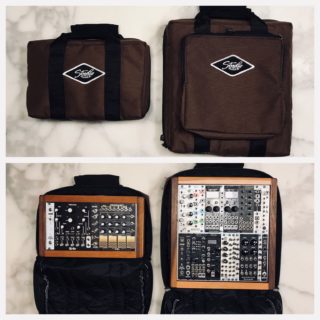Reader Robin Heisey shared these thoughts on creating a modular synthesizer setup that’s tailored to traveling:
“I’ve spent a while trying to figure out how to make a modular system truly portable, always struggling with compromises to functionality versus size.
My latest iteration seems to have hit a sweet spot, combining two light weight wood skiffs and a number of 8hp recreations of Ornament & Crime and Mutable Instruments modules.
Once you travel a bit, especially traveling with just carry-on, you soon realize how big and how heavy even a small Eurorack system can be. Even fairly light cases like the Intellijel aluminum 4U skiffs add up, once you include the power brick – and even 84hp can be a stretch in size for a knapsack. And my experience is that you can’t ever check anything valuable in the hold, so small is essential.

My latest system achieves low weight and maximum packing flexibility by splitting the system into two light wooden skiffs from Art For The Ears, one 6U and one 3U. Both are 42hp wide, giving a total of 126hp. The power supplies connect with a daisy chain cable so you only need one 4hp power module for both cases.
Choosing which modules to include is relatively easy; choosing which ones to leave out is trickier. I love the immediacy of the 4MS QCD, so while there are smaller clock modules, I had to include that one. A few 2HP modules give a lot of bang for the buck, and I’ve included a mixer, an envelope generator (with a hand output attenuator built-in), a dual attenuator, delay and reverb, all from 2HP. I’ve learned you can overdo it with 2hp and 3hp modules – they get almost impossible to work with when you have too many crammed together, so the idea is to limit how many, and to try to spread them out.
Having two Ornament & Crime modules is fabulous – a number of the O_C apps have quantizing built in, like the sequencer app Sequins, so it’s kind of like getting two in one – and given there are two independent sequencers in Sequins, both with separate quantizing functions, it’s almost like four in one. With the µO_C, you also get Euclidean Rhythms, or Quadrature LFOs, or a quad envelope generator, and lots more, all in 8hp.
To protect the cases on the road, I had Studio Slips make cases for both skiffs. The larger unit goes in my roll-aboard bag, leaving lots of room for clothes and other actual essentials; the smaller one goes in my personal item (knapsack), and still leaves me room for my small laptop and other stuff. Further space and weight can be saved by using things like Modular Addicts’ skinny cables, and a few Tip-Top Stackables in lieu of multiple modules.
My latest trip included a stop near an olive orchard. Despite the heat I was able to set up and enjoy a nice little ambient jam. I captured the outside ambience with the iPhone’s own mic; the modular itself was recorded direct into my MacBook Air.”
Thanks to Heisey for the technical details. You can see the system in action in the video above, Modular Ambient En Plein Air.
If you’ve got your own tips to share on traveling with modular gear, share them in the comments!

this seems like good info, and more posts like this would definitely be interesting